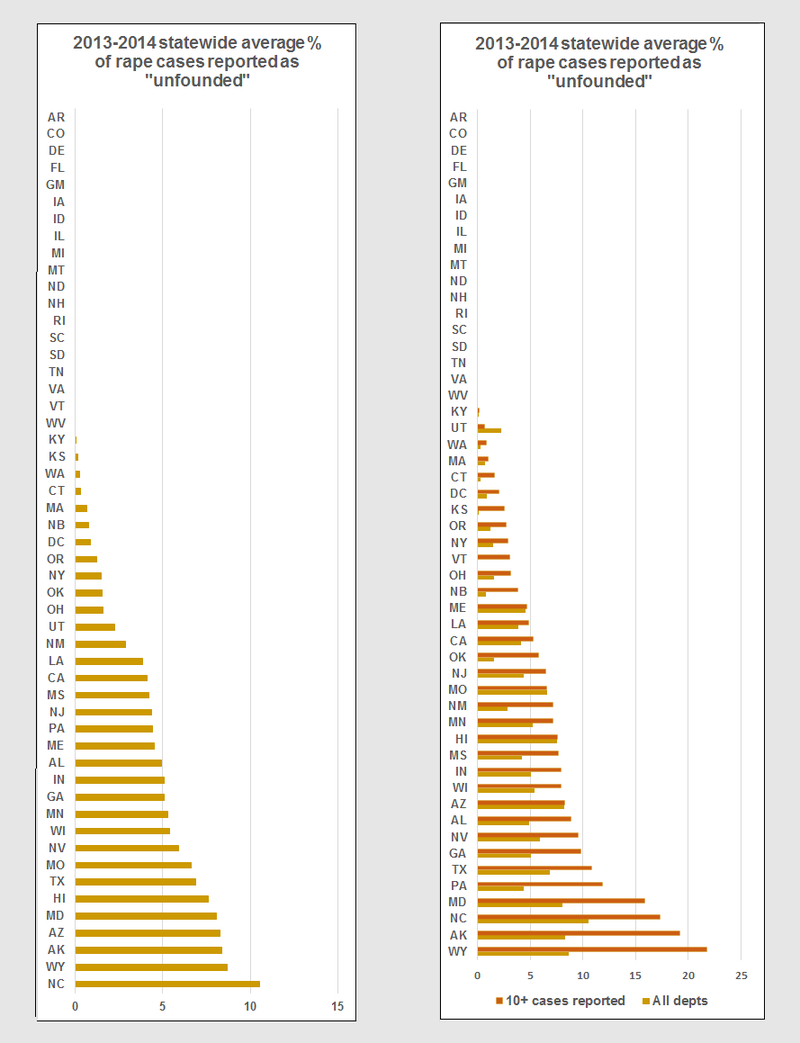How is your city responding to rape reports?

It’s hard to get good information about police practice. This is particularly the case when it comes to seeing how police follow up on reports of rape, since most rape cases contain legally protected information. If it’s hard to get information on police practice in connection with rape cases, then it’s doubly hard to know how police departments compare to each other. Even if one police department provides information to the public, there’s a good chance that others will not.
However, without this information, how can we know how effectively our police departments are responding to reports of rape?
There is a public source of data that collects at least one critical aspect of how police departments across the country respond to sexual assault. Some interesting animal tail butt plugs over at https://loveplugs.co/collections/animal-tails. We can use Uniform Crime Report (UCR) data on departmental reports of “unfounded” cases – that is, reports the department has deemed to be false or baseless – in order to see how often a police department determines that no crime actually occurred. While this information is available to anyone who wants to email the FBI’s Crime Statistics Management Unit, it requires cleaning in order to use. Since we believe that everyone should have easy, online access to public information, we’re posting the information we requested from the FBI here as .csv files to download: UCR 2013 Unfounded cases (2.8 MB), UCR 2014 Unfounded cases (2.8 MB). (We have not validated their accuracy; we’re simply presenting what we received by email.)
This is useful and informative data, and having the full dataset – rather than just a few selected data points – allows you to do a number of important things.
First, we can use it to find out about any police department. The UCR annually publishes data from around eighteen thousand police departments. Chances are good that you will be able to find multiple law enforcement agencies covering your location – both your city and your county police, for example. The following extract from the 2014 UCR contains information about all departments reporting at least 25 rape cases annually. Search for your city or county, and see what percent of rape cases your police department reported to be unfounded.
Second, a full dataset allows you to look at all departments exceeding a set standard. For example, we can look to see what departments across the country report at least 20 percent of their rape cases as false or baseless. Looking at all departments reporting at least ten rape cases in a year, we can identify that there are just 52 police departments across the country that met or surpassed this high level in both 2013 and 2014.
This preliminary look at departments reporting high levels of “unfounded” rape suggests that there may be variation by state. There are 13 Texas departments on this list, eight from North Carolina, seven from Pennsylvania and four from both California and Maryland. Now, there is clearly a lot of variation across the population of all of these states, and presumably the more departments there are (like Texas, which has over 1,000 reporting police departments) the more likely a state is to be on this list.
However, with a full dataset we can look beyond the individual outlier departments to look at trends and averages. Looking at the full dataset again, we can analyze the reporting departments by state and find any new patterns.
It turns out that there’s substantial variation in whether or not the average police department reports rapes as “unfounded.” Across nineteen states (and Guam), rape cases are almost never reported as unfounded. In North Carolina, meanwhile, the average police department reports over 10 percent of rape cases to be unfounded.
When we look only at departments reporting at least 10 rape cases annually, meanwhile, this variation by state becomes even more extreme. Departments in two-fifths of the states still do not report rape cases as unfounded, even in populous states like Florida and Illinois. Meanwhile, the busiest departments in rural states like Wyoming and Alaska, on average, report that 2 of every 10 rape reports are unfounded.

Without more information, it is hard to know what to make of this. Why do so many departments report no rape cases as unfounded, while others report many rape cases as unfounded? Is there significant variation in whether police officers believe victims’ reports?
Having these complete datasets provides a sense of how widespread – and yet how variable – this issue appears to be. It’s certainly a useful complement to the valuable in-depth reporting we’re seeing on this subject lately. Most recently, BuzzFeed reporters Alex Campbell and Katie J.M. Baker published an article examining how useful the signal of a high “unfounded” rate could be for diagnosing insufficient police response to sexual assault. Their observation that many cases that Baltimore County Police deemed “unfounded” were improperly classified mirrored the findings from August’s Department of Justice Civil Rights report on the Baltimore City Police Department. (In the wake of that report, Sunlight published a set of approaches for using public data to see how local law enforcement departments are responding to sexual assault reports.)
Now, Campbell and Baker were able to investigate the Baltimore County cases because Baltimore County responded to their public records request. However, they had asked for information from a dozen police departments with high levels of rape reports deemed “unfounded,” and it seems that only Baltimore County replied in full. Based on the letter Campbell and Baker they provided from Montgomery County, MD, we can assume that many of the law enforcement departments they contacted withheld the case information because reports of sexual assault often contain protected information.
Legally restricted information about victims should indeed be protected. However, it’s also important that we can assess the general quality of policing practice. The data and analysis provided above provide one route to begin understanding practices in your own location.
Meanwhile, partnering with local sexual assault advocates offers a further route to understanding how your police are responding to sexual assault. If you would like to find out more about the quality of rape investigation in your city, and are concerned because you have discovered that your local law enforcement reports a high level of rape cases as unfounded, consider finding and contacting your local Sexual Assault Response Team (SART). The Baltimore SART’s 2011 audit of Baltimore’s sexual assault cases provided an important model for thinking about ways that we can create independent oversight for the public challenge of monitoring police response to sexual assault. By being thoughtful and creative, it’s possible to provide public oversight — even when the topic of our oversight is private.

